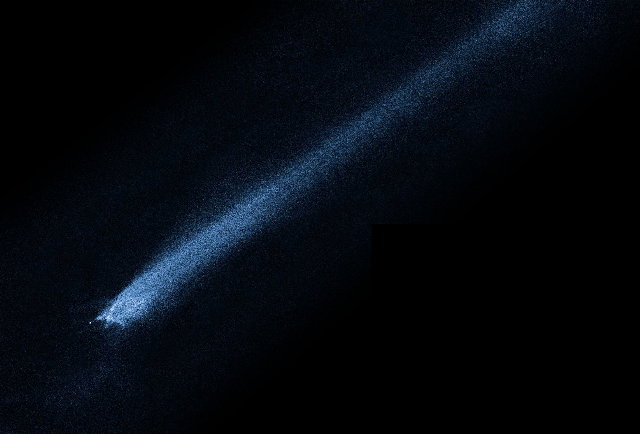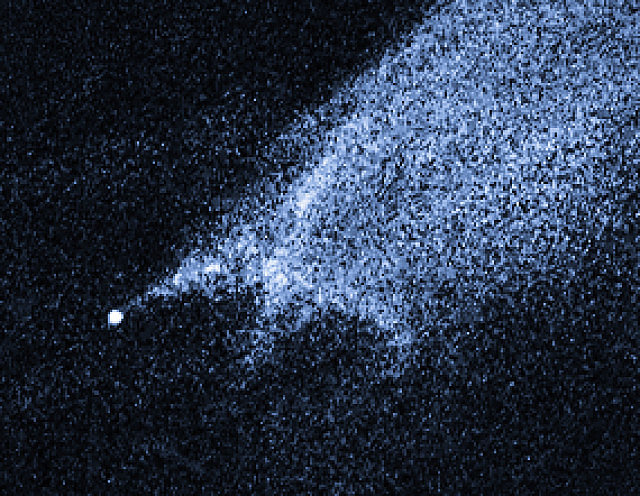

| Visitors Now: | |
| Total Visits: | |
| Total Stories: |

| Story Views | |
| Now: | |
| Last Hour: | |
| Last 24 Hours: | |
| Total: | |
Asteroid Oljato’s Mysterious Magnetic Disturbance
read more at Anne’s Astronomy News http://annesastronomynews.com/
Back in the 1980s, the arrival of asteroid 2201 Oljato inside the orbit of Venus heralded a flurry of magnetic activity. Now, results from ESA’s Venus Express spacecraft suggest that Oljato has lost its magnetic mojo. Dr Christopher Russell has presented an explanation for Oljato’s strange behaviour at the European Planetary Science Congress in Madrid on Tuesday 25th September.

This is a NASA Hubble Space Telescope picture of a comet-like object called P/2010 A2, which was first discovered by the LINEAR (Lincoln Near-Earth Asteroid Research program) sky survey on January 6. The object appears so unusual in ground-based telescopic images that discretionary time on Hubble was used to take a close-up look. This picture, from the January 29 observation, shows a bizarre X-pattern of filamentary structures near the point-like nucleus of the object and trailing streamers of dust. Image Credit: NASA, ESA, and D. Jewitt (UCLA)
Oljato orbits the Sun once every 3.2 years. During its lifetime, NASA’s Pioneer Venus Orbiter observed three passages of Oljato between Venus and the Sun. Each time, there was a marked increase in the region of unusual magnetic peaks known as Interplanetary Field Enhancements (IFEs), both ahead and behind the asteroid.
Russell said, “This is not typical asteroidal behaviour! These magnetic increases are rare, occurring in Venus orbit about 10 times per year. Pioneer observed that when Oljato was just in front or just behind Venus, the rate of IFEs approximately trebled. And yet, in more recent observations with Venus Express, the occurrence of IFEs is now lower than the average we find outside this region.”

The comet-like object called P/2010 A2. Image Credit: NASA, ESA, and D. Jewitt (UCLA)
Russell and his team believe that the answer to this discrepancy lies with collisions between Oljato and debris in its orbit. When objects collide in interplanetary space, they become electrically charged and dust particles are accelerated by the solar wind.
Russell explained, “At one point in time Oljato shed boulders – mostly a few tens of metres in diameter – into its orbit and they formed a debris trail in front and behind Oljato. These impactors then hit other targets as they passed between Venus and the Sun. The large amount of fine dust released by these collisions was picked up by the solar wind, producing the IFEs observed by Pioneer, and was accelerated out of the Solar System.”
This close-up picture of the comet-like object P/2010 A2 shows a complex structure that suggests the object is not a comet but instead the product of a head-on collision between two asteroids traveling five times faster than a rifle bullet (5 kilometers per second). Astronomers have long thought that the asteroid belt is being ground down through collisions, but such a smashup has never before been seen.
The filaments are made of dust and gravel, presumably recently thrown out of the 460-foot-diameter nucleus. Some of the filaments are swept back by radiation pressure from sunlight to create straight dust streaks. Embedded in the filaments are co-moving blobs of dust that likely originate from tiny unseen parent bodies. An impact origin would also be consistent with the absence of gas in spectra recorded using ground-based telescopes.
At the time of the Hubble observations, the object was approximately 180 million miles (300 million km) from the Sun and 90 million miles (140 million km) from Earth. The Hubble images were recorded with the new Wide Field Camera 3 (WFC3). The image was taken in visible light. The color in the image is not what the human eye would see. A blue color map was added to bring out subtle details.
Image Credit: NASA, ESA, and D. Jewitt (UCLA)
The reduced rate of IFEs observed during the Venus Express epoch suggests that the collisions with Oljato’s co-orbiting material have reduced the general debris in the region as well as the co-orbiting material shed by Oljato.
“The IFEs observed by Pioneer suggest that more than 3 tonnes of dust was being lost from the region each day. Effects associated with solar heating and gravitational perturbations have gradually nudged larger chunks of debris away from Oljato’s orbit. From once being unusually crowded, the region has become unusually clear and free of IFEs,” said Russell.
Source: Europlanet
n/a
2012-09-26 20:43:19
Source:



